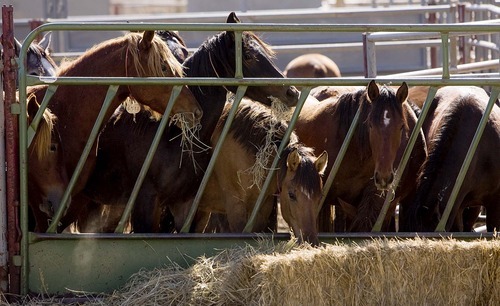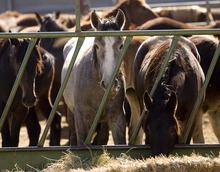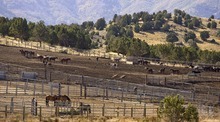This is an archived article that was published on sltrib.com in 2011, and information in the article may be outdated. It is provided only for personal research purposes and may not be reprinted.
Unable to battle mud to make a suitable home for captured wild horses on a Herriman hillside, the U.S. Bureau of Land Management this week is sending animals to two other Utah holding areas in anticipation of closing the site.
The Salt Lake Regional Wild Horse and Burro Center, under fire since a video by a wild horse advocate showed animals swamped in mud and manure last spring, will continue holding horses seasonally for at least two years — but not in the wet season.
"We just can't quite manage the mud and manure during the winter," said Jill Silvey, Salt Lake Field Office manager for the BLM. Inspections this year, including by an agricultural engineer, determined it's impractical to even try on a hillside that occasionally sees heavy snowfall.
"It's literally an uphill battle," she said. "The numbers would be staggering, in the millions [of dollars]."
The horses remaining at Herriman — about 100 at this point — will be moved to Gunnison and Delta. The BLM will reopen the center next summer, shut it down again next fall, and adopt horses there again for a final season in 2013, Silvey said. That will give the center's four employees time to seek other employment. It's possible seasonal adoptions could resume there in the future, she said, but not year-round corralling.
The Cloud Foundation, a Colorado-based wild horse advocacy group that posted video of mucky conditions at the center last April, questioned why it took such a report to get the horses to drier ground. The group supports keeping the animals on public lands, while the government contends it must periodically cull the free-roaming herds to protect native plants and wildlife.
"We want to know why the BLM kept them in the mud and manure in the first place," said Cloud Foundation spokeswoman Anne Novak. "Wild horses are national treasures. They deserve their freedom on the range, not to be captured and kept in slop."
After the YouTube video showed horses walking and lying in deep mud, the BLM invited a Humane Society of Utah inspector to view conditions. At that time, the inspector told The Salt Lake Tribune that while conditions may not be ideal, the animals appeared to be in good health and no animal cruelty laws were violated.
Nonetheless, an internal review ultimately recommended moving the horses where they wouldn't confront the mud problem.
The center was intended as a seasonal adoption locale 15 years ago when the government leased it for $1 a year from Kennecott Utah Copper, Silvey said. Eventually it began housing horses year-round because the agency lacked capacity elsewhere.
The location was ideal in years past because it was in a rural, "horsey" expanse on the edge of a metropolitan area, Silvey said. Development has since closed in, and she said it might make more sense to move adoption events around the valley on special occasions.
Wild horse adoptions nationwide are down significantly in the past five years, possibly due to economic hardship and escalating hay prices. Where adoptions once stood at 7,000 a year, Silvey said, now they're at 3,000.









